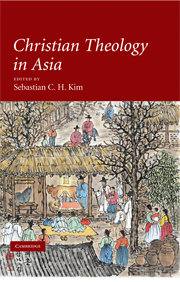Book contents
- Frontmatter
- Contents
- Contributors
- Preface and Acknowledgements
- 1 FORMATION OF CHRISTIAN THEOLOGIES IN ASIA
- II THEOLOGICAL THEMES OF CHRISTIANITY IN ASIA
- 8 Religious pluralism, dialogue and Asian Christian responses
- 9 Cross-textual hermeneutics and identity in multi-scriptural Asia
- 10 Re-constructing Asian feminist theology: toward a glocal feminist theology in an era of neo-Empire(s)
- 11 The ecumenical movement in Asia in the context of Asian socio-political realities
- 12 Mission and evangelism: evangelical and pentecostal theologies in Asia
- 13 Subalterns, identity politics and Christian theology in India
- Index
- References
11 - The ecumenical movement in Asia in the context of Asian socio-political realities
Published online by Cambridge University Press: 05 June 2012
- Frontmatter
- Contents
- Contributors
- Preface and Acknowledgements
- 1 FORMATION OF CHRISTIAN THEOLOGIES IN ASIA
- II THEOLOGICAL THEMES OF CHRISTIANITY IN ASIA
- 8 Religious pluralism, dialogue and Asian Christian responses
- 9 Cross-textual hermeneutics and identity in multi-scriptural Asia
- 10 Re-constructing Asian feminist theology: toward a glocal feminist theology in an era of neo-Empire(s)
- 11 The ecumenical movement in Asia in the context of Asian socio-political realities
- 12 Mission and evangelism: evangelical and pentecostal theologies in Asia
- 13 Subalterns, identity politics and Christian theology in India
- Index
- References
Summary
THE ‘ECUMENICAL’ IN THE CONTEXT OF ASIA
The word ‘ecumenical’ has many shades of meaning and is used in a variety of ways. Therefore, it is important to understand the special meaning it has acquired in the Asian context. The original Greek word ‘oikoumene’ in the Roman world simply meant, ‘the whole inhabited earth’. At the height of Roman power, the occupied territories of the empire were equated with ‘the whole inhabited earth’. Ecumenism, therefore, had to do originally with what happened in the territories of the empire. However, ever since the church became a prominent part of the empire, successive emperors had to deal with the problem of divisions within the church over the interpretation of the Christian faith. They feared that disunity and divisions within the church would harm the unity and coherence of the empire itself. Thus, the emperors themselves wanted to preserve the unity of the church and from time to time brought the bishops of the oikoumene (the occupied territories) together, if need be by the use of force, and put pressure on them to come to agreements on questions of doctrine so that the ‘unity of the oikoumene’ might be preserved. These councils that the Emperors organized were the ancient ‘ecumenical councils’ that drew up many of the classical doctrinal statements and the Creeds – like the Nicene Creed.
- Type
- Chapter
- Information
- Christian Theology in Asia , pp. 227 - 249Publisher: Cambridge University PressPrint publication year: 2008
References
- 3
- Cited by



